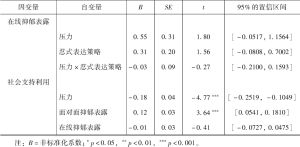章节
压力与社会支持利用:自我表露和忍式表达策略的作用
摘要
本研究旨在检验面对面和在线自我表露在压力与社会支持利用之间的中介作用,以及忍式表达策略对两个中介变量的调节作用。本研究通过在线调查网站征集了578名被试,问卷调查结果表明:压力对社会支持利用具有显著的负向直接效应;对于抑郁、焦虑情绪,面对面自我表露在压力与社会支持利用之间具有显著的遮掩效应,而通过在线自我表露的间接效应不显著;对于抑郁情绪,忍式表达策略在压力与面对面自我表露之间具有显著的调节作用;以及忍式表达策略对两个间接效应的调节作用都不显著。这些研究结果表明,在压力情境下,提高面对面的抑郁、焦虑表露深度可以为改善个体的社会支持利用提供一条有效的途径,而忍式表达策略对于提高面对面的抑郁表露深度具有积极意义。
检索正文关键字
章节目录
-
一 引言
- (一)压力与社会支持利用
- (二)面对面自我表露与在线自我表露的中介作用
- (三)忍式表达策略的调节作用
-
二 研究方法
- (一)被试
- (二)研究工具
- 1.抑郁-焦虑-压力量表(Depression Anxiety Stress Scale,DASS-21)
- 2.情绪自我表露量表(Emotional Self-Disclosure Scale,ESDS)
- 3.社会支持评定量表(Social Support Rating Scale,SSRS)
- 4.忍式情绪表达问卷(Expressive Forbearance Questionnaire,EFQ)
- (三)统计处理
-
三 结果
- (一)描述性分析
- (二)中介效应分析
- (三)有调节的中介效应检验
- 四 讨论
- 五 结论
查看更多>>>










